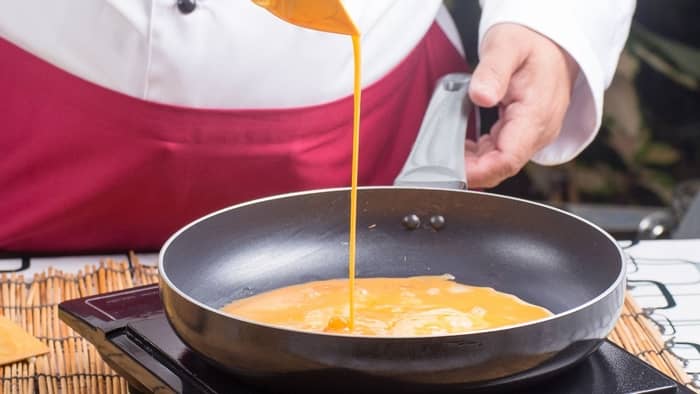Last Updated on January 6, 2023
Liquid eggs vs real eggs – ever wondered what the differences are? Today, we will answer this question and look at all things liquid eggs!
The biggest difference between these two forms of eggs is the state they are sold in. Liquid eggs come in blended liquid form whereas regular eggs are sold whole in their shell. This is only one difference between them, and today, we will look at every aspect. This includes how they are made, sold, and used their nutritional value, and even how you can make liquid eggs at home!
What Are Liquid Eggs?
Liquid eggs, also commonly known as breaker eggs, are exactly like regular eggs but are sold in liquid form. The eggs have been broken out of their shell and whisked together to create an egg fluid that is usually sold in juice boxes.
Liquid eggs naturally don’t contain any eggshell or eggshell pieces and have a yellow color to them. The yellow color comes from the egg yolk, exactly like it would when whisking whole eggs together at home.
<CENTERZ
</CENTERHow Liquid Eggs are Made
Factories usually make liquid eggs, but the process is fairly simple. The eggs are screened for any debris, cracks, or other abnormalities. Then, the whole eggs are cracked and poured into a mechanism that separates the egg whites from the egg yolks.
This is when the eggs are pasteurized. The reason the egg whites and yolks are pasteurized separately is that they need different temperatures to kill certain bacteria without cooking – you can look below for more information on the pasteurization process.
Once the eggs have been pasteurized, the blending process begins. To create liquid whole eggs, the producer has to combine the correct ratio of egg white to egg yolk. Once measured, they can combine the two components and package them.
Production Processes – Pasteurization
Liquid eggs are almost always pasteurized and homogenized. Both of these processes help reduce the risk of foodborne illnesses, especially in raw (uncooked) products like eggs.
When liquid eggs are pasteurized, the eggs are basically heated to a specific temperature that is high enough to kill certain harmful microorganisms, but not too high to start cooking the eggs. The eggs should start at room temperature before being pasteurized. Once the eggs have been heated, they are immediately and quite rapidly cooled back to room temperature.
As we have mentioned, this process helps reduce the risk of any microorganisms growing inside the juice box and makes pasteurized liquid eggs a very safe product.
Liquid Eggs Marketing
This is actually a very important topic, especially because baking is a science that requires specific ingredients (and quantities) to perform specific functions.
When a product has been labeled as “liquid whole egg”, it has to have the correct ratio of egg white and egg yolk that a regular egg has.
If they don’t, the manufacturer should state the ratios on the juice box. Many of them do sell only “liquid egg whites” or “liquid egg yolks”.
Liquid Egg Nutrition
The nutrition of liquid eggs depends on the ratio of egg white to egg yolk. If you have whole liquid eggs, their nutrition will be pretty much the same as compared to regular eggs.
However, if you have yolk-only liquid eggs, they will have the nutrition of only the yolks and none of the whites’. The same goes the other way around. Liquid egg whites don’t have many nutrients, just like regular egg whites don’t.
Now, manufactured liquid eggs aren’t usually made from powdered eggs, but if they are, their nutrition will differ a lot from fresh egg products. Powdered eggs have been dehydrated which causes a loss in nutrient value.
Liquid Eggs Vs Real Eggs – Comparison
So, finally! Liquid eggs vs real eggs – what are the actual differences? Well, first, the obvious, is the physical characteristics. Regular eggs are sold whole and still inside the eggshell. Liquid eggs come without a shell and are incompletely blended in liquid form. They are also sold in juice boxes instead of egg cartons.
They both are still made from real fresh eggs and have virtually the same nutritional makeup when comparing one regular egg with one liquid whole egg. This also means that both have a similar color (yellow) when mixed.
They both will still function in exactly the same way in baking and cooking. Liquid eggs can also act as a binding ingredient, help enrich products like bread and cakes, add nutritional value to meals, and help give color.
A big difference is how the eggs can be cooked alone. For example, liquid eggs cannot be boiled or poached whereas regular eggs can.
Learn more about Is Buttermilk Lactose-Free? What Are The Best Buttermilk Substitutes?
Liquid Egg Recipes
There are a ton of liquid egg recipes on the internet, but personally, we feel that everyone is over-complicating the process. It is actually extremely simple! There are mainly two types of liquid eggs you can make.
Fresh Liquid Egg Recipe
First, you have to decide what you want. Do you need whole eggs, only egg whites, or only egg yolks, or do you need a specific ratio of egg whites to yolks? This method allows you to perfectly customize the liquid eggs to your needs.
All you do then is blend the components separately and remix them using the correct ratios.
The biggest pro of using this method is that you are using fresh eggs, but at the same time that is what makes this method a little less than ideal. The fresh eggs won’t last nearly as long as a powder-based recipe and you will have to use the liquid eggs within 4 days.
But, it is a great method to use if you need bulk eggs in liquid form!
Powdered liquid egg recipe
These liquid eggs will last a little bit longer considering they come from the powdered form. They could possibly last a few weeks in the fridge!
For this method, you will need about 2 cups of water for every 150 grams of egg powder (unless your package states otherwise).
You can simply place the water inside a large bottle, slowly add the egg powder, and shake it vigorously after every addition to properly combine the components.
You can actually buy egg powder at the grocery store, but you can also make your very own at home.
How To Use Liquid Whole Eggs
With liquid, you can make fried eggs, use them to make scrambled eggs, or make many different kinds of omelets. It can also be used as-is to help crumb ingredients to create a crispy layer. It also works great as an egg-wash to help add color and stick pastries together.
You can use liquid eggs to make cakes, pancakes, muffins, bread, and virtually anything else you can think of that uses eggs! One thing to keep in mind is that you should always check that the liquid eggs have the correct ratio of egg whites and yolks that you need.
Read more about Quick, Easy, and Flavor-packed Pineapple Topping For Cheesecake
How Much Liquid Egg Equals 1 Large Egg?
It’s very easy to replace a large egg with a liquid egg, but you may be wondering how much to use. One large egg is equivalent to around four tablespoons of liquid eggs. However, if the recipe has one large egg white or a medium-sized egg, it may be best to use between two to three tablespoons of liquid egg. If you follow these guidelines, it’s easy to replace one for the other in any recipe!
How Long Do Frozen Liquid Eggs Last?
If you didn’t already know, you can absolutely freeze liquid eggs. If you’re doing so, it’s best to do this when they haven’t yet been opened. This is because the shelf life of products massively decreases once a product has been opened. Frozen liquid eggs will last in the freezer for up to a year if stored correctly.
How Do You Measure Liquid Eggs?
To measure out liquid eggs, you can just use a teaspoon or tablespoon; it’s super easy to do. For example, if you’re measuring egg whites, for one large egg white, you’ll need two tablespoons of liquid eggs, which is around 30ml. For a cup of liquid eggs, you’d need around 8-10 large egg whites. Similarly, for a cup of liquid eggs for egg yolks, you’d need around 12-16 large egg yolks.
Who Sells Liquid Eggs?
Most local grocery stores, including stores such as Walmart, will sell liquid eggs. Some of the most popular brands of liquid eggs you may want to look out for are Eggland’s Best, Great Value, JUST Egg, Rose Acre Farms, Cargill, Nest Fresh Egg, Bumble Hole Foods, D Wise, Bob Evans, Nature Egg.
How Much is a Liquid Egg?
Liquid eggs are not typically sold individually. If you’re looking for the average price of a carton of liquid eggs, then look no further. The cheapest available is from Great Value at Walmart and costs just under $4.50 for a 32 oz carton. These liquid eggs are cage-free and contain the following ingredients:
- egg whites
- natural flavor
- color
- spice
- salt
- onion powder
- xanthan gum
- guar gum
- vitamins and minerals
How Many Eggs Are in 1 Litre of Liquid Eggs?
The amount of eggs in a liter of liquid eggs depends on whether the liquid egg is whole eggs or just egg whites. Let’s take a look at both. When it comes to whole eggs, a liter of liquid eggs is equivalent to around 20 medium-sized eggs. However, when it comes to egg whites, a liter of liquid egg whites is equivalent to around 30 medium-sized eggs.
How to Make Liquid Eggs at Home?
If you’re looking to make your own liquid eggs at home (which are freeze-able and super convenient), then look no further. The only ingredients you’ll need are 6 egg whites, 1/4 cup of dry milk powder, and 1 tablespoon of vegetable oil. Now all you need to do is add the egg whites, milk powder, and oil to a bowl and whisk. Keep whisking until the ingredients are completely combined and smooth. Now transfer to a sealable container or jar. They’ll keep for around 1 week in the refrigerator, or up to a year in the freezer.
Final Thoughts
If you found this article on real eggs vs liquid eggs useful, please share it with your baking buddies. You can also let us know how you love to use your liquid eggs or if you have a special recipe.

Lindy Van Schalkwyk is a culinary specialist with a background in Advanced Cooking, Advanced Pâtisserie, Media Communications and Nutrition. She has gained invaluable experience in the culinary industry having worked in some of the top restaurants in Africa in 2016 and 2017. Her expertise in nutrition has enabled her to develop recipes for special dietary needs. In 2018, Lindy began working in the Food Media industry, focusing on recipe development, recipe writing, food writing and food styling.




